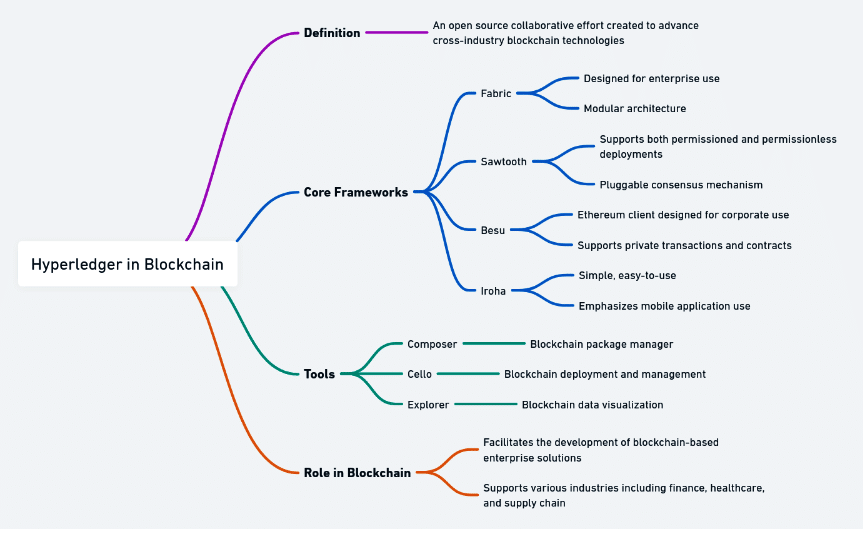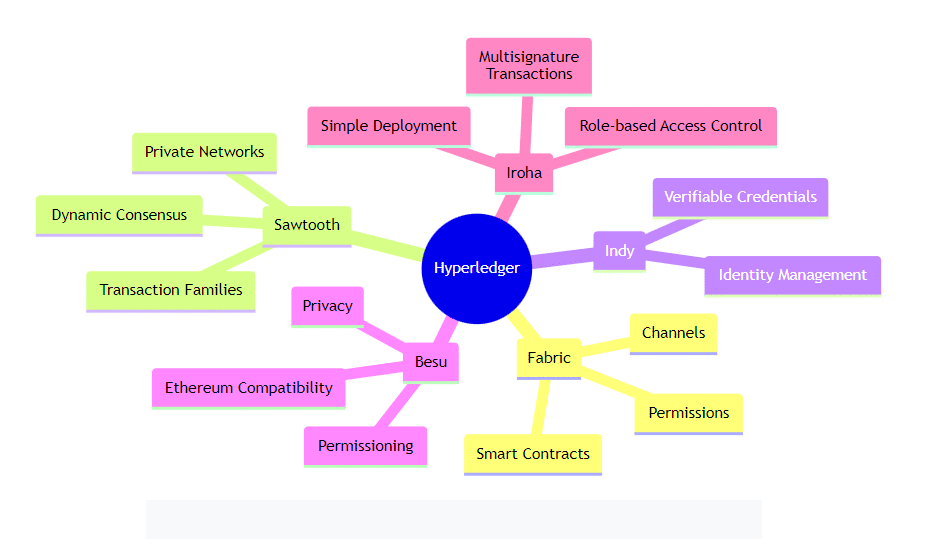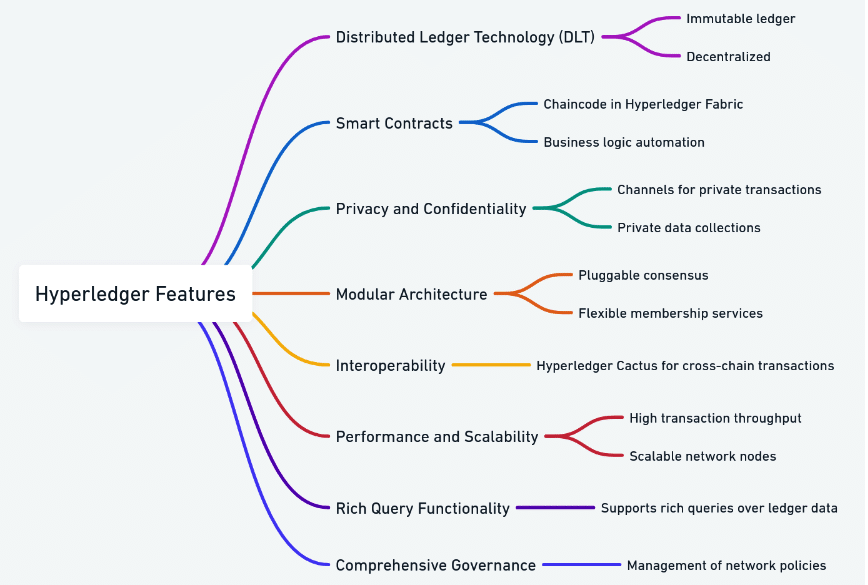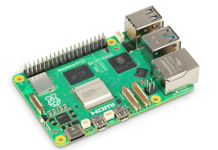Hyperledger stands out as a comprehensive suite of open source blockchain frameworks
and tools designed to meet the diverse needs of modern enterprises. By offering robust,
scalable, and modular solutions, it empowers organisations to leverage blockchain
technology for enhanced security, transparency, and efficiency.
Hyperledger is an open source collaborative effort to help advance cross-industry blockchain technologies. Hosted by the Linux Foundation, Hyperledger provides a platform for developing decentralised applications (dApps), enterprise-grade distributed ledger frameworks, and smart contracts. It encompasses various blockchain frameworks, libraries, and tools tailored to different use cases, aiming to foster innovation, interoperability, and standardisation in blockchain development.
Hyperledger projects typically focus on permissioned or private blockchain networks, where participants are known and authenticated, making it particularly suitable for enterprise applications requiring scalability, privacy, and regulatory compliance.

Why do we need Hyperledger?
Hyperledger is needed to provide a reliable, scalable, and flexible blockchain framework tailored for enterprise use, supporting a variety of applications across industries while fostering collaboration, innovation, and compliance. There are other reasons too.
Secure transactions: Hyperledger provides a secure platform for conducting transactions without the need for intermediaries, ensuring trust and reliability in digital transactions.
Transparent record-keeping: Hyperledger’s distributed ledger technology offers transparency and immutability, ensuring that all parties have access to the same, tamper-proof records, reducing disputes and fraud.
Cost efficiency: By eliminating intermediaries and streamlining processes, Hyperledger helps reduce transaction costs, making it more cost-effective for businesses to conduct transactions and manage their operations.
Decentralisation: Hyperledger enables decentralisation, removing the need for a central authority to control transactions and data, empowering individuals and organisations with greater control over their assets and information.
Scalability: Its modular architecture allows for scalability, enabling businesses to easily scale their blockchain networks and applications to meet growing demand and accommodate increasing transaction volumes.
Privacy: Hyperledger offers privacy features, allowing businesses to control access to sensitive information while still maintaining transparency and accountability in their transactions.
Interoperability: By promoting interoperability between different blockchain networks and systems, Hyperledger enables seamless communication and data exchange across disparate platforms, enhancing collaboration and compatibility.
Industry-specific solutions: Hyperledger provides frameworks and tools tailored to specific industries, such as finance, supply chain, healthcare, and more, addressing industry-specific challenges and requirements with customised blockchain solutions.
Innovation: It fosters innovation through open source collaboration, allowing developers and organisations to contribute to and leverage cutting-edge blockchain technology to drive digital transformation and create new business opportunities.
Compliance and regulation: Hyperledger facilitates compliance with regulatory requirements by providing features such as permissioned networks, privacy controls, and audit trails, ensuring that businesses can meet legal and regulatory obligations while leveraging blockchain technology.

How does Hyperledger work?
Hyperledger works by providing a set of frameworks and tools that enable the creation, deployment, and management of enterprise-grade blockchain networks. Each Hyperledger framework and tool addresses specific needs, allowing organisations to choose the components that best fit their use case.
- Permissioned network: Hyperledger operates on a permissioned network where participants are known and authenticated.
- Consensus mechanism: It uses modular consensus mechanisms, allowing organisations to choose the protocol that suits their needs.
- Smart contracts: Smart contracts, called chaincode, define transaction logic and rules.
- Transaction processing: Transactions are proposed by clients, endorsed by peers, ordered into blocks, and then committed to the ledger.
- Ledger management: Hyperledger maintains a world state representing the current blockchain state and a transaction log recording all transaction history.
- Privacy and access control: Features like channels and private data collections ensure privacy and selective sharing.
- Identity management: Solutions authenticate and authorise network participants for secure interactions and data access.
- Scalability and efficiency: Hyperledger’s architecture emphasises scalability, security, and efficiency for enterprise needs.
Hyperledger frameworks and tools
Hyperledger provides several frameworks and tools for building blockchain-based solutions. Here are some of the key frameworks and tools offered under the Hyperledger umbrella.
Hyperledger Fabric
- Modular blockchain framework designed for enterprise use.
- Supports permissioned networks with a focus on confidentiality, scalability, and flexibility.
- Features pluggable consensus protocols, smart contract support (chaincode), and a robust permission model.
- Suitable for a wide range of applications, including supply chain management, trade finance, and healthcare.
Hyperledger Sawtooth
- Modular platform for building, deploying, and running distributed ledgers.
- Utilises a unique consensus algorithm called Proof of Elapsed Time (PoET) and supports Ethereum-based smart contracts (Solidity).
- Offers scalability, security, and flexibility for various use cases such as supply chain tracking, digital identity, and financial services.
Hyperledger Besu
- Ethereum client built on Java, enabling private and public blockchain deployments.
- Supports Ethereum Virtual Machine (EVM) execution and Ethereum-based smart contracts.
- Offers enterprise-grade features like privacy, permissioning, and scalability.
- Suitable for industries such as finance, supply chain, and government.
Hyperledger Indy
- Framework for decentralised identity management.
- Designed to provide individuals, organisations, and connected devices with self-sovereign identity capabilities.
- Offers features like verifiable credentials, decentralised identifiers (DIDs), and zero-knowledge proofs for privacy.
- Aimed at applications requiring secure, interoperable, and user-controlled identity solutions.
Hyperledger Aries
- Infrastructure for interoperable identity solutions.
- Complements Hyperledger Indy by providing a toolkit for building decentralised identity systems and peer-to-peer interactions.
- Offers protocols, data models, and cryptographic primitives for secure and portable identity interactions.
- Enables use cases like verifiable credentials, decentralised identifiers, and secure messaging.
Hyperledger Caliper
- Blockchain benchmarking tool for measuring the performance of blockchain platforms.
- Supports various blockchain frameworks, including Hyperledger Fabric and Sawtooth.
- Allows users to define and execute performance tests to evaluate throughput, latency, and resource utilisation.
- Useful for optimising and comparing the performance of different blockchain deployments.

Hyperledger features
Modularity: Hyperledger is designed to be modular, allowing users to select and combine components that best fit their specific use cases. This modularity enables flexibility and customisation, accommodating diverse requirements across different industries and applications.
Permissioned blockchains: Hyperledger supports permissioned blockchain networks, where participants are known and trusted. This model contrasts with permissionless blockchains like Bitcoin, which allow anyone to join the network and participate anonymously. Permissioned blockchains are suitable for enterprise use cases where privacy, scalability, and regulatory compliance are critical.
Distributed ledger technology (DLT): It provides a framework for building distributed ledger applications. Distributed ledgers maintain a shared, replicated, and synchronised database across multiple nodes, ensuring transparency, immutability, and resilience to failures or attacks.
Consensus mechanisms: Hyperledger offers pluggable consensus mechanisms, allowing network participants to choose one that best suits their requirements. Consensus mechanisms determine how transactions are validated and added to the blockchain. Hyperledger supports various consensus algorithms, including Practical Byzantine Fault Tolerance (PBFT), Raft, and Proof of Elapsed Time (PoET).
Smart contracts and chaincode: It supports the execution of smart contracts, often referred to as ‘chaincode’ in Hyperledger Fabric, one of its most prominent frameworks. Chaincode enables the implementation of business logic and rules governing transactions within the blockchain network. Smart contracts facilitate automation, enforce agreements, and enable complex interactions among participants.
Privacy and confidentiality: Hyperledger prioritises privacy and confidentiality features, particularly in enterprise settings where sensitive business information is involved. It provides mechanisms for encrypting data, restricting access to certain transactions or data fields, and ensuring that only authorised participants can view or transact on specific parts of the blockchain.
Permissioned membership: It allows organisations to control access to their blockchain networks through membership services. Participants must be authenticated and authorised to join the network, ensuring that only trusted entities can interact with the blockchain. Membership services manage identities, permissions, and access control within the network.
Scalability and performance: Hyperledger aims to provide scalable and high-performance blockchain solutions suitable for enterprise-grade applications. It employs techniques such as parallel transaction processing, sharding, and off-chain data storage to enhance throughput and reduce latency, enabling efficient handling of large transaction volumes.
Interoperability: Hyperledger promotes interoperability by providing standards, protocols, and tools for integrating blockchain solutions with existing enterprise systems, applications, and networks. Interoperability enables seamless data exchange and collaboration across multiple platforms.
Enterprise support and governance: It fosters a vibrant community of developers, contributors, and users, providing resources, documentation, and support for building and deploying blockchain solutions. Additionally, it emphasises enterprise-grade governance practices, ensuring transparency, consensus-driven decision-making, and long-term sustainability of the project.
The pros and cons of Hyperledger
Hyperledger has many advantages.
Modularity: Hyperledger’s modular architecture allows organisations to select and customise components that best fit their use case, leading to greater flexibility and interoperability.
Permissioned network: Permissioned networks, where participants are known entities, enhance privacy, scalability, and efficiency compared to public blockchains like Bitcoin or Ethereum.
Enterprise focus: Hyperledger is designed with enterprise requirements in mind, including features such as identity management, confidentiality, performance, and scalability, making it suitable for business applications.
Diverse frameworks: It encompasses various frameworks like Fabric, Sawtooth, Indy, and Besu, each catering to different use cases and industries, providing options for developers and organisations based on their specific requirements.
Strong governance: Being under the Linux Foundation, Hyperledger benefits from robust governance and industry collaboration, ensuring transparency, security, and long-term sustainability.
But there are a few disadvantages too.
Complexity: Implementing and deploying Hyperledger frameworks can be complex due to their modular nature and the need for specialised knowledge in blockchain development. This complexity may increase development time and cost.
Limited decentralisation: Hyperledger’s focus on permissioned networks may restrict decentralisation compared to public blockchains. While this can be advantageous in certain enterprise scenarios, it may not align with the principles of decentralisation desired by some organisations.
Learning curve: Hyperledger frameworks often require a steep learning curve, especially for developers who are new to blockchain technology. Understanding concepts like consensus algorithms, smart contracts, and network configuration can be challenging.
Resource intensive: Some Hyperledger frameworks, like Hyperledger Fabric, can be resource intensive in terms of computing power and storage requirements, particularly as the network scales. This may pose challenges for organisations with limited resources.
Evolving ecosystem: While Hyperledger has a vibrant community and is backed by industry leaders, the ecosystem is still evolving. This may result in limited tooling, documentation, and support compared to more established technologies.
The collaborative, community-driven approach of Hyperledger helps to accelerate the development and adoption of blockchain solutions. As industries continue to explore the potential of blockchain, Hyperledger remains at the forefront, providing the tools and frameworks necessary to build the next generation of enterprise applications.
















































































